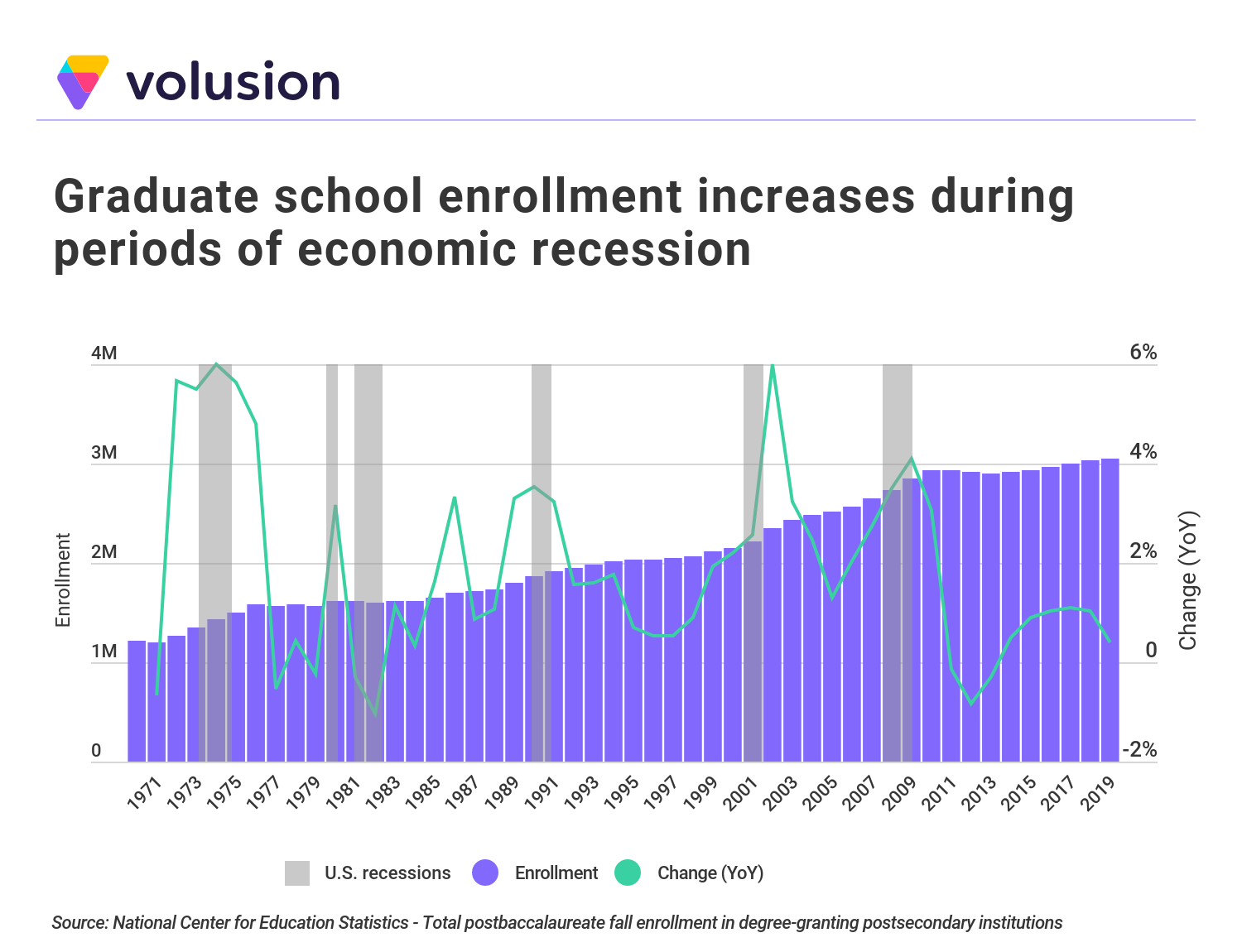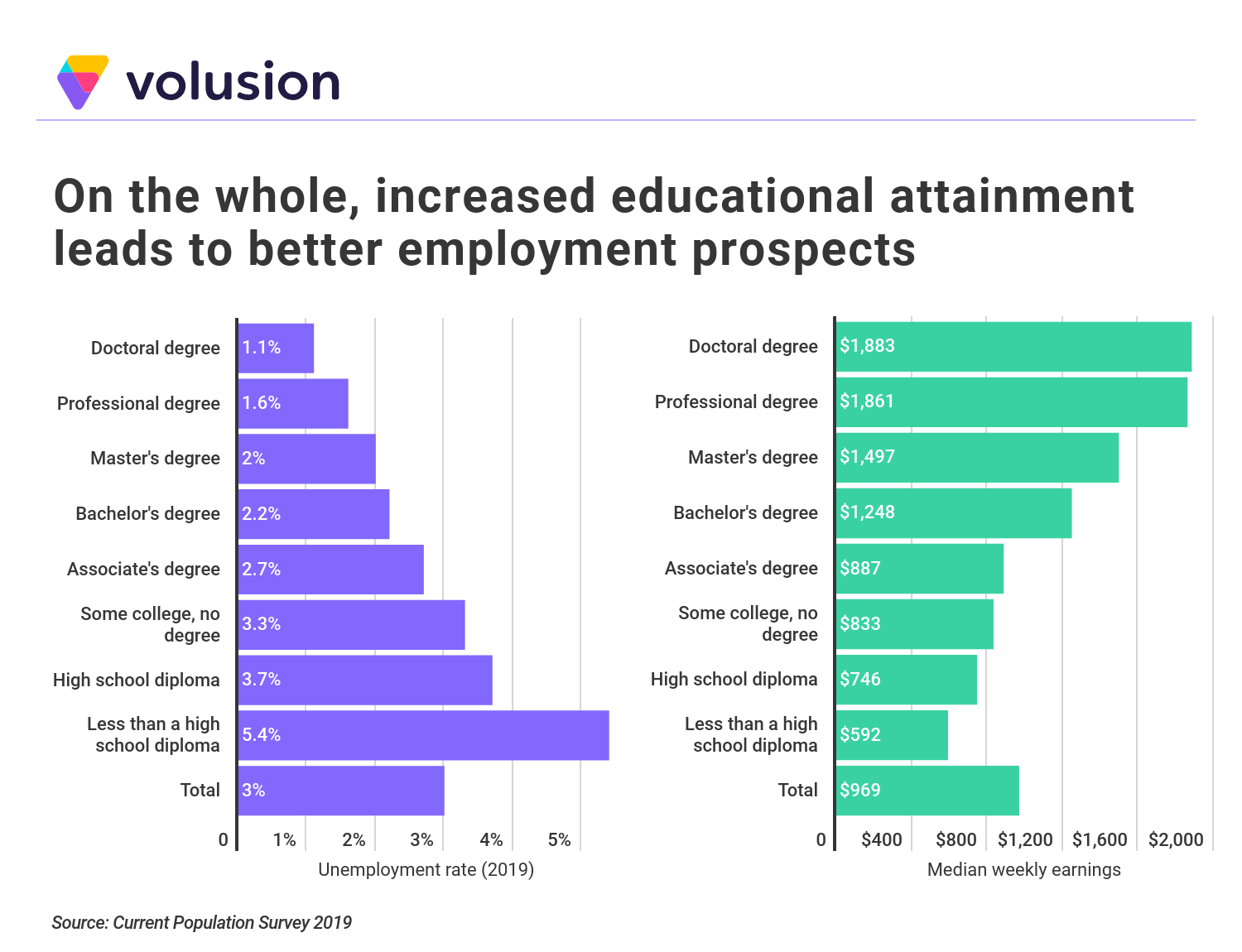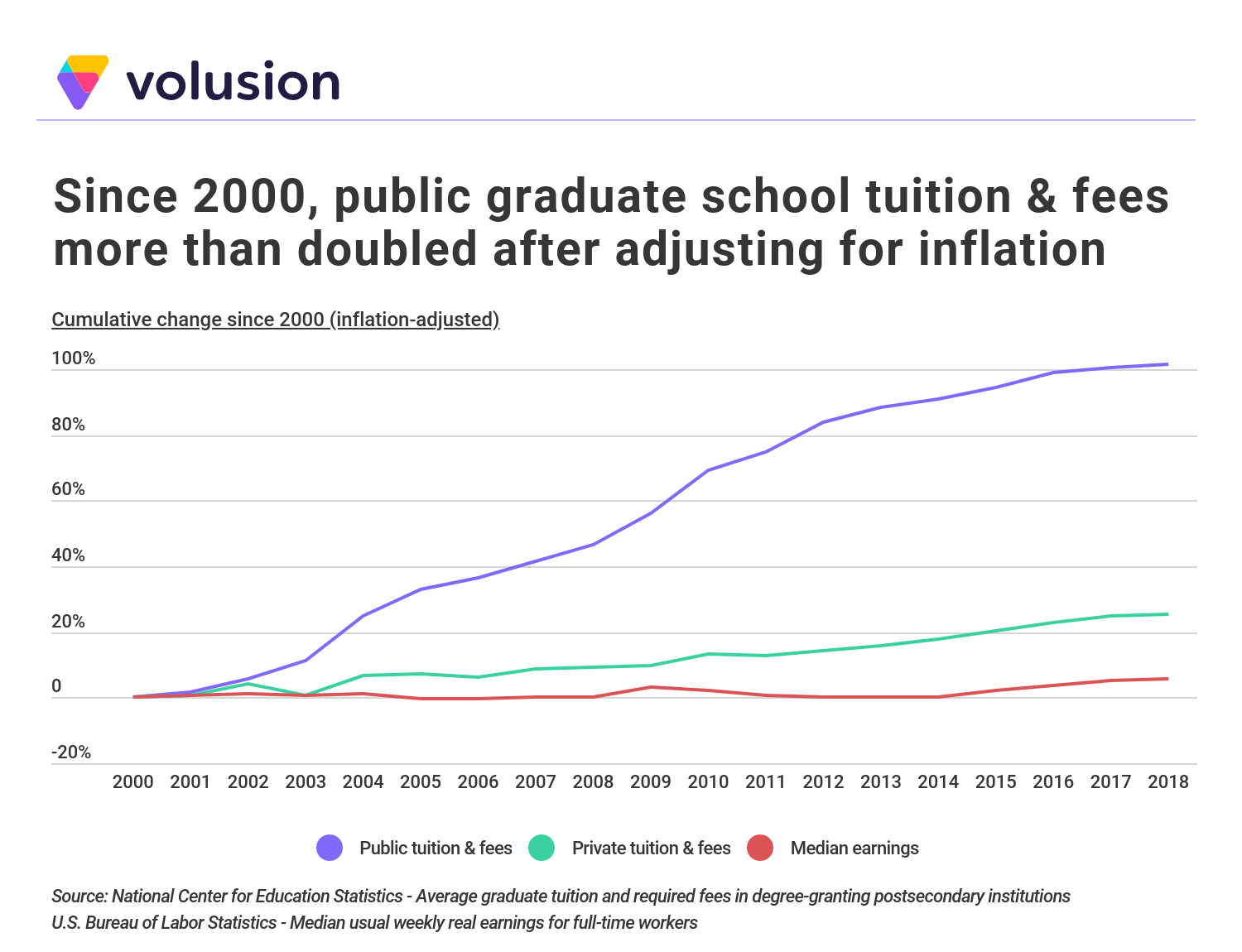
The National Bureau of Economic Research recently announced that the U.S. officially entered a recession in February 2020. Unprecedented levels of unemployment and declines in economic activity triggered by the COVID-19 pandemic abruptly ended the economy’s 10-year period of expansion. With job prospects looking bleak for the near future, pursuing an advanced degree may become an attractive option for recent college graduates and those who find themselves unemployed.
While enrollment in graduate programs fluctuates from year to year, it tends to spike during economic downturns. According to data from the National Center for Education Statistics, dramatic increases in graduate enrollment occurred in 1980-1982 and 2001-2002, when the economy was in recession. More recently, enrollment in graduate and professional programs increased about 7.3 percent between 2008 and 2010, the height of the Great Recession. Over the past five years, however, graduate school enrollment plateaued and then decreased as the economy recovered. As of 2019, there were 3.05 million students enrolled in an advanced degree program.

For many people, attending a graduate program is a good option and an advanced degree translates into better job prospects and higher earnings when the economy returns to normal. Individuals with a college education report lower-than-average unemployment rates and higher median wages compared to those without a degree. In general, the more advanced the degree, the greater the economic benefit. For example, the median weekly wages in 2019 for doctoral degree holders ($1,883) and professional degree holders ($1,861) were about twice as high as the median wage of $969 per week for all workers. In 2019, the unemployment rate for those with a master’s degree, professional degree, or doctorate was also at or below 2 percent, compared to the overall unemployment rate then of 3 percent.

However, the skyrocketing cost of both undergraduate and graduate education is causing many to rethink whether or not the investment in an advanced degree is worth it. Adjusted for inflation, the average graduate school tuition increased by 101 percent at public universities and 26 percent at private universities over the past 20 years. For context, median weekly earnings for full-time workers increased by less than 6 percent after adjusting for inflation over the same time period.

Research from the National Center for Education Statistics also found that the average cumulative debt (undergraduate and graduate combined) was $108,400 for individuals who pursue research doctorate degrees, $186,600 for professional doctorate degrees, and $66,000 for master’s degrees. For individuals who took out loans to pay for their undergraduate education, incurring additional debt for graduate school, while possible, often results in crippling monthly loan payments after graduation.
Fortunately, there are many lucrative jobs that don’t require graduate school. To find the highest-paying occupations that don’t require an advanced degree, researchers at Volusion analyzed salary and employment data from the U.S. Bureau of Labor Statistics’ Employment Projections Survey. In addition to salary data, Volusion also included the BLS’s 10-year projected employment growth for each occupation, as compared to the national average of 5.2 percent. It’s important to note, though, that the BLS’s employment projections for 2018-2028 were made prior to COVID-19, and new projections don’t yet exist.
Here’s what they found:
The 10 Best-Paying Jobs That Don’t Require an Advanced Degree

Photo Credit: Alamy Stock Photo
10. Advertising and promotions managers
- Median annual wage: $125,510
- Work experience needed: Less than 5 years
- Highest concentration of jobs: New York-Newark-Jersey City, NY-NJ-PA
- 10-year projected job growth (pre-COVID): 3.2%
Advertising and promotions managers are responsible for producing advertising campaigns to be used in media such as radio, television, print, and the web in order to generate interest in a company’s products or services. Advertising managers might work in-house for a company or department, or for an agency that works with many different clients. The 10-year projected job growth of 3.2 percent is lower than the overall growth rate, but individuals can pursue this career path without a lot of work experience.

Photo Credit: Alamy Stock Photo
9. Sales managers
- Median annual wage: $126,640
- Work experience needed: Less than 5 years
- Highest concentration of jobs: San Jose-Sunnyvale-Santa Clara, CA
- 10-year projected job growth (pre-COVID): 5.1%
Sales managers supervise the sales team within a company and set sales goals on a quarterly and/or annual basis. Sales managers might specialize in business-to-business (B2B) sales on behalf of wholesalers and manufacturers, or they might work in retail or ecommerce businesses to manage business-to-consumer (B2C) sales. The 10-year projected job growth for sales managers is on par with the average across all occupations. While the highest concentration of sales manager jobs are in the San Jose metro area, sales is a ubiquitous job function available in nearly every city and can also be done remotely.

Photo Credit: Alamy Stock Photo
8. Natural sciences managers
- Median annual wage: $129,100
- Work experience needed: 5 years or more
- Highest concentration of jobs: Durham-Chapel Hill, NC
- 10-year projected job growth (pre-COVID): 5.9%
Natural sciences managers oversee scientific research projects and production from chemists, physicists, and biologists. Interestingly, the highest concentration of natural sciences manager jobs is in the Durham-Chapel Hill metro area, which is also known as the “Research Triangle” due to the proximity of North Carolina State University, Duke University, and University of North Carolina at Chapel Hill. The 10-year projected job growth is slightly higher than the average across all occupations.

Photo Credit: Alamy Stock Photo
7. Financial managers
- Median annual wage: $129,890
- Work experience needed: 5 years or more
- Highest concentration of jobs: Bridgeport-Stamford-Norwalk, CT
- 10-year projected job growth (pre-COVID): 16.0%
Financial managers undertake a variety of financial initiatives within an organization, such as compiling financial reports, directing investment activities, and creating plans for long-term financial health. Financial managers often work in banks and insurance companies, but they can work in any type of company or industry. Financial managers are poised to have the highest 10-year projected job growth on this list, at more than three times the overall average.

Photo Credit: Alamy Stock Photo
6. Marketing managers
- Median annual wage: $136,850
- Work experience needed: 5 years or more
- Highest concentration of jobs: Bridgeport-Stamford-Norwalk, CT
- 10-year projected job growth (pre-COVID): 8.1%
Marketing managers work within organizations or agencies to determine consumer demand for a product or service, define a target audience, and launch relevant marketing campaigns. Marketing managers often work in tandem with advertising partners and sales teams in order to create print and digital promotional materials. The projected job growth by 2028 is greater than the average for all jobs, and most marketing managers have more than five years of experience.

Photo Credit: Alamy Stock Photo
5. Petroleum engineers
- Median annual wage: $137,720
- Work experience needed: None
- Highest concentration of jobs: Midland, TX
- 10-year projected job growth (pre-COVID): 2.6%
Petroleum engineers design equipment and methods used in extracting oil and gas. While much of their work is done in offices, petroleum engineers are likely to work in locations close to drilling and well sites. For example, the highest concentration of petroleum engineering jobs is located in Midland, Texas. The 10-year projected job growth is about half of the overall average. In the wake of COVID-19, there will likely be even bigger job losses in the industry due to the decline in gas prices and demand for travel.

Photo Credit: Alamy Stock Photo
4. Architectural and engineering managers
- Median annual wage: $144,830
- Work experience needed: 5 years or more
- Highest concentration of jobs: San Jose-Sunnyvale-Santa Clara, CA
- 10-year projected job growth (pre-COVID): 2.8%
Architectural and engineering managers work in offices and construction sites to direct activities related to architecture and engineering projects. The projected job growth for this profession is below the overall average. With construction projects, especially residential, dropping precipitously as a result of COVID-19, work for architectural and engineering managers may also be on the decline for the near future.

Photo Credit: Alamy Stock Photo
3. Computer and information systems managers
- Median annual wage: $146,360
- Work experience needed: 5 years or more
- Highest concentration of jobs: San Jose-Sunnyvale-Santa Clara, CA
- 10-year projected job growth (pre-COVID): 11.3%
Computer and information systems managers assist organizations with analyzing and implementing information technology needs. These managers often install hardware and software, create data security plans, and upgrade technology systems. The projected growth rate for this field is about twice as high as the overall average. Not surprisingly, the highest concentration of jobs for this field is located in the San Jose metro area, the heart of Silicon Valley.

Photo Credit: Alamy Stock Photo
2. Airline pilots, copilots, and flight engineers
- Median annual wage: $147,220
- Work experience needed: Less than 5 years
- Highest concentration of jobs: Anchorage, AK
- 10-year projected job growth (pre-COVID): 4.6%
The main job duties for airline pilots, copilots, and flight engineers involve transporting passengers and cargo by air. These professionals must obtain a commercial pilot’s license and an FAA-issued Airline Transport Pilot (ATP) certificate in order to fly aircrafts such as airplanes and helicopters. The projected growth rate for this occupation was already below the overall average prior to COVID-19, but the flight industry faces an even more uncertain future as the pandemic decreases demand for travel.

Photo Credit: Alamy Stock Photo
1. Chief executives
- Median annual wage: $184,460
- Work experience needed: 5 years or more
- Highest concentration of jobs: Nashville-Davidson–Murfreesboro–Franklin, TN
- 10-year projected job growth (pre-COVID): -5.5%
Chief executives are typically the highest position within an organization. Any company or industry can have a chief executive, so this is one of the most flexible jobs on the list. Chief executives usually work with a board of directors and other managers within an organization to direct operational activities and implement high-level business strategies. However, chief executives are the only occupation on the list with a negative job growth rate.
Methodology & Full Results
Statistics on median wages, work experience, education, and projected job growth are from the U.S. Bureau of Labor Statistics’ Employment Projections Survey. Only occupations requiring a bachelor’s degree or lower were included in the analysis. Median wages are for 2019 and the 10-year projected change in employment is for the years 2018-2028.
Employment concentrations by metropolitan area are from the U.S Bureau of Labor Statistics’ Occupational Employment Statistics Survey. For each occupation, the metro with the “highest concentration of jobs” is the metro with the largest share of employment in that occupation relative to the share of employment in that occupation at the national level.
All occupations in the list offer a median salary at least three times higher than the national median of $39,810 per year. However, most of these jobs do require a bachelor’s degree, and just over half require at least five years of experience. While graduate degrees may not be required for any of the jobs on the list, it will usually take both time and effort to reach these higher salaries.
While many of the jobs on the list can be done from anywhere with an internet connection, a few are more location-dependent. For example, petroleum engineers and architectural and engineering managers usually need access to job sites. Airline pilots are also beholden to the locations of their airports and flight itineraries. As the economy gradually reopens after COVID-19, jobs that rely on in-person interaction or travel will likely take longer to recover compared to those that can be performed remotely.
* This article was originally published here
HELP STOP THE SPREAD OF FAKE NEWS!
SHARE our articles and like our Facebook page and follow us on Twitter!





0 Comments